Choosing a Gaming CPU: Single + Multi-GPU at 1440p, April 2013
by Ian Cutress on May 8, 2013 10:00 AM ESTCPU Benchmarks
Point Calculations - 3D Movement Algorithm Test
The algorithms in 3DPM employ both uniform random number generation or normal distribution random number generation, and vary in amounts of trigonometric operations, conditional statements, generation and rejection, fused operations, etc. The benchmark runs through six algorithms for a specified number of particles and steps, and calculates the speed of each algorithm, then sums them all for a final score. This is an example of a real world situation that a computational scientist may find themselves in, rather than a pure synthetic benchmark. The benchmark is also parallel between particles simulated, and we test the single threaded performance as well as the multi-threaded performance.
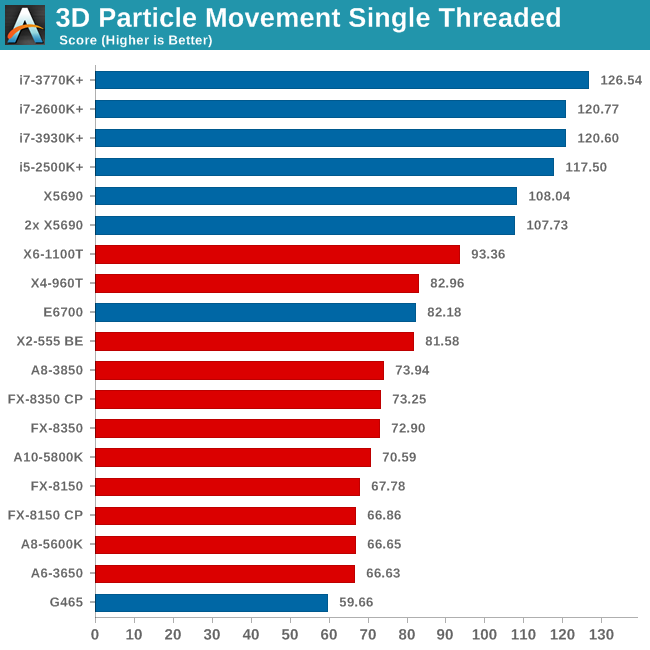
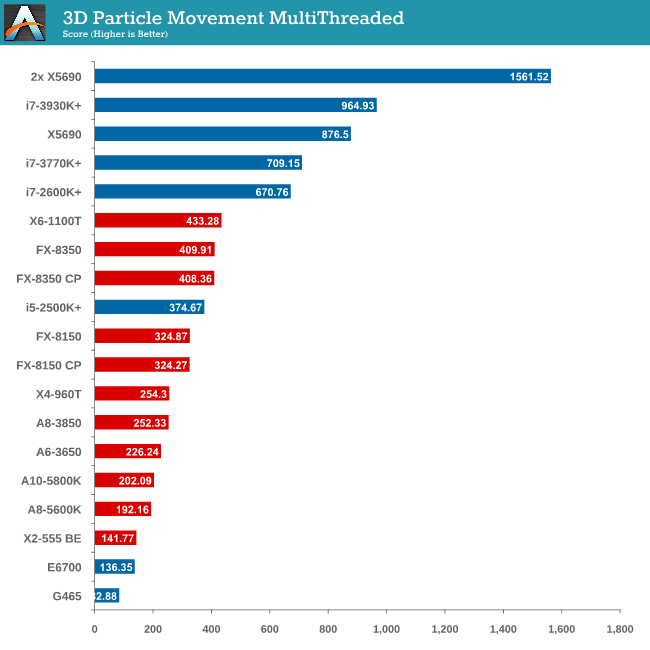
As mentioned in previous reviews, this benchmark is written how most people would tackle the situation – using floating point numbers. This is also where Intel excels, compared to AMD’s decision to move more towards INT ops (such as hashing), which is typically linked to optimized code or normal OS behavior.
Compression - WinRAR x64 3.93 + WinRAR 4.2
With 64-bit WinRAR, we compress the set of files used in our motherboard USB speed tests. WinRAR x64 3.93 attempts to use multithreading when possible and provides a good test for when a system has variable threaded load. WinRAR 4.2 does this a lot better! If a system has multiple speeds to invoke at different loading, the switching between those speeds will determine how well the system will do.
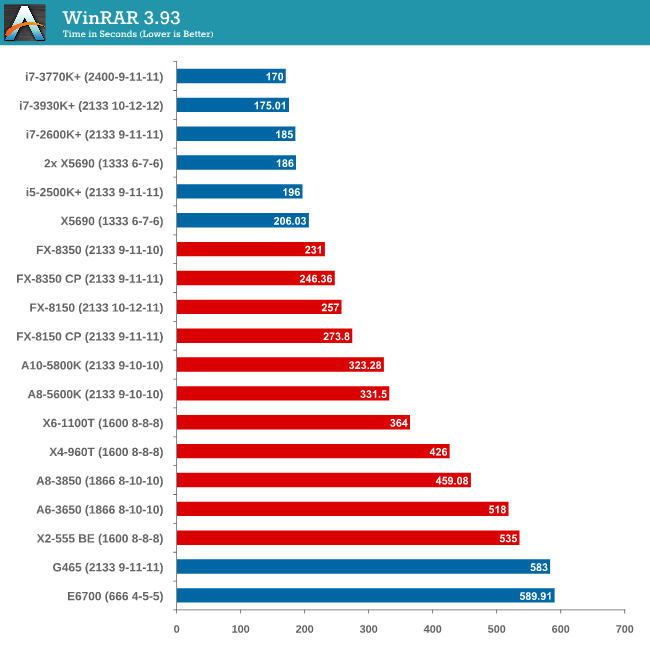

Due to the late inclusion of 4.2, our results list for it is a little smaller than I would have hoped. But it is interesting to note that with the Core Parking updates, an FX-8350 overtakes an i5-2500K with MCT.
Image Manipulation - FastStone Image Viewer 4.2
FastStone Image Viewer is a free piece of software I have been using for quite a few years now. It allows quick viewing of flat images, as well as resizing, changing color depth, adding simple text or simple filters. It also has a bulk image conversion tool, which we use here. The software currently operates only in single-thread mode, which should change in later versions of the software. For this test, we convert a series of 170 files, of various resolutions, dimensions and types (of a total size of 163MB), all to the .gif format of 640x480 dimensions.
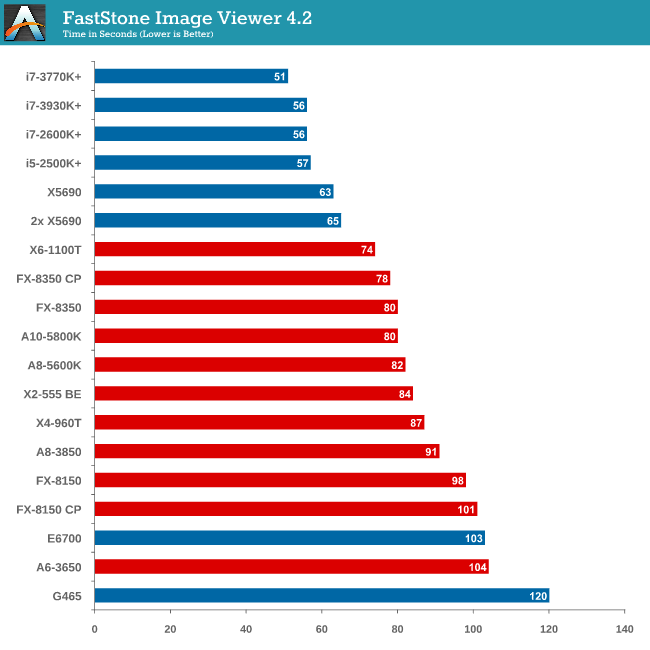
In terms of pure single thread speed, it is worth noting the X6-1100T is leading the AMD pack.
Video Conversion - Xilisoft Video Converter 7
With XVC, users can convert any type of normal video to any compatible format for smartphones, tablets and other devices. By default, it uses all available threads on the system, and in the presence of appropriate graphics cards, can utilize CUDA for NVIDIA GPUs as well as AMD WinAPP for AMD GPUs. For this test, we use a set of 33 HD videos, each lasting 30 seconds, and convert them from 1080p to an iPod H.264 video format using just the CPU. The time taken to convert these videos gives us our result.
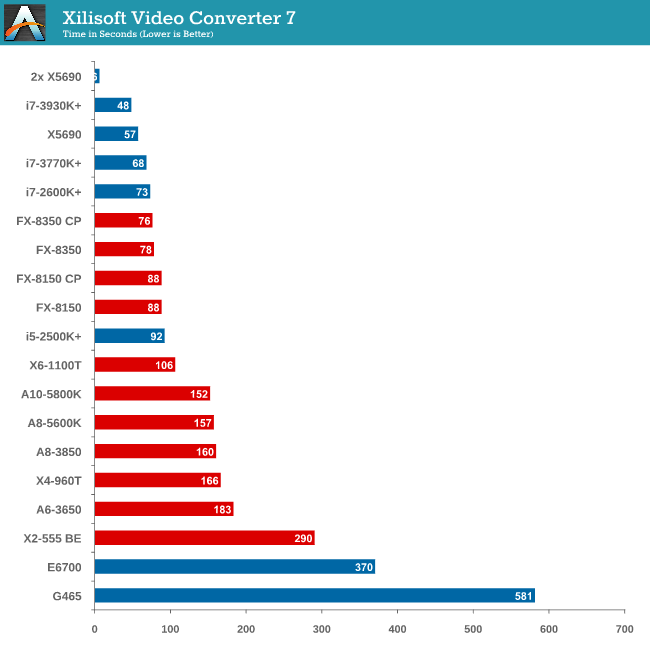
XVC is a little odd in how it arranges its multicore processing. For our set of 33 videos, it will arrange them in batches of threads – so if we take the 8 thread FX-8350, it will arrange the videos into 4 batches of 8, and then a fifth batch of one. That final batch will only have one thread assigned to it (!), and will not get a full 8 threads worth of power. This is also why the 2x X5690 finishes in 6 seconds but the normal X5690 takes longer – you would expect a halving of time moving to two CPUs but XVC arranges the batches such that there is always one at the end that only gets a single thread.
Rendering – PovRay 3.7
The Persistence of Vision RayTracer, or PovRay, is a freeware package for as the name suggests, ray tracing. It is a pure renderer, rather than modeling software, but the latest beta version contains a handy benchmark for stressing all processing threads on a platform. We have been using this test in motherboard reviews to test memory stability at various CPU speeds to good effect – if it passes the test, the IMC in the CPU is stable for a given CPU speed. As a CPU test, it runs for approximately 2-3 minutes on high end platforms.
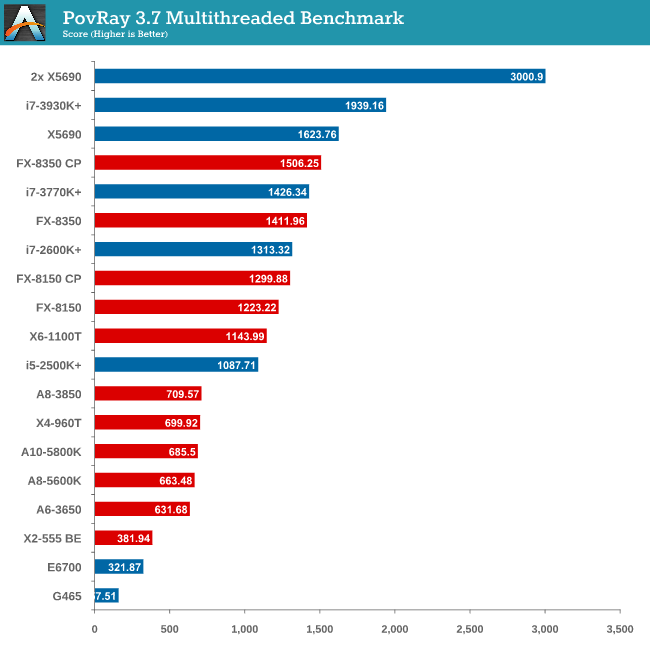
The SMP engine in PovRay is not perfect, though scaling up in CPUs gives almost a 2x effect. The results from this test are great – here we see an FX-8350 CPU below an i7-3770K (with MCT), until the Core Parking updates are applied, meaning the FX-8350 performs better!
Video Conversion - x264 HD Benchmark
The x264 HD Benchmark uses a common HD encoding tool to process an HD MPEG2 source at 1280x720 at 3963 Kbps. This test represents a standardized result which can be compared across other reviews, and is dependent on both CPU power and memory speed. The benchmark performs a 2-pass encode, and the results shown are the average of each pass performed four times.
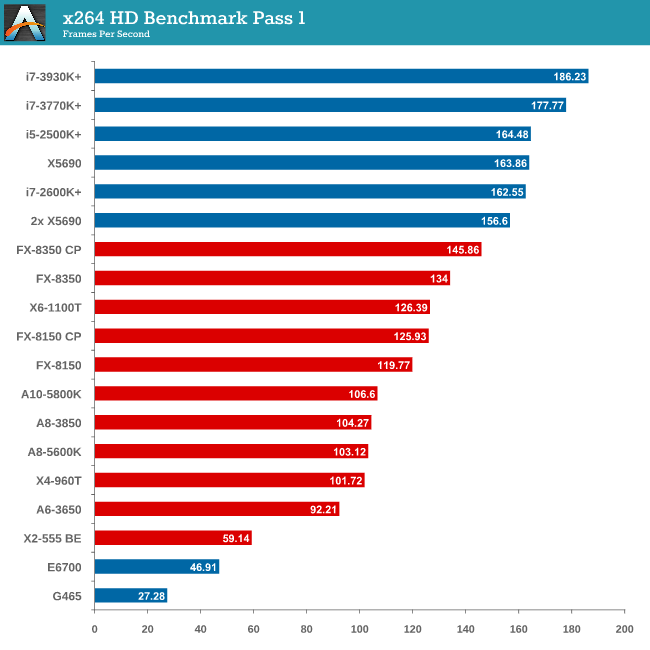
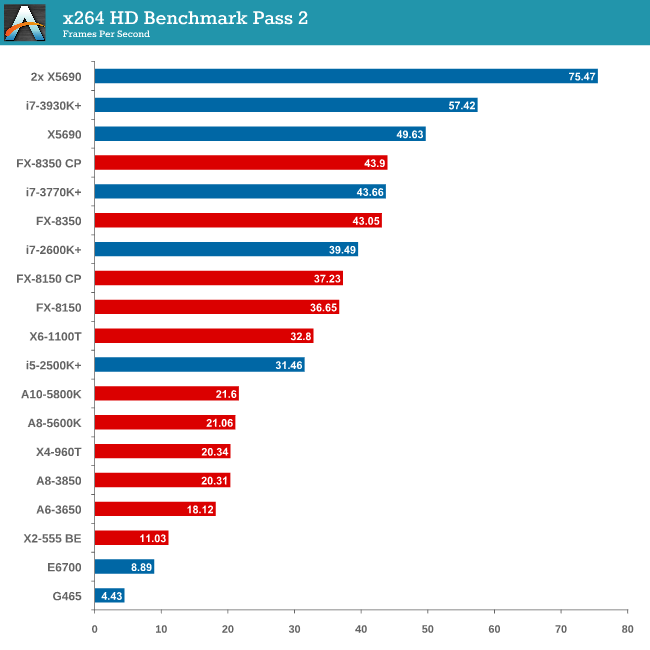
Grid Solvers - Explicit Finite Difference
For any grid of regular nodes, the simplest way to calculate the next time step is to use the values of those around it. This makes for easy mathematics and parallel simulation, as each node calculated is only dependent on the previous time step, not the nodes around it on the current calculated time step. By choosing a regular grid, we reduce the levels of memory access required for irregular grids. We test both 2D and 3D explicit finite difference simulations with 2n nodes in each dimension, using OpenMP as the threading operator in single precision. The grid is isotropic and the boundary conditions are sinks. Values are floating point, with memory cache sizes and speeds playing a part in the overall score.
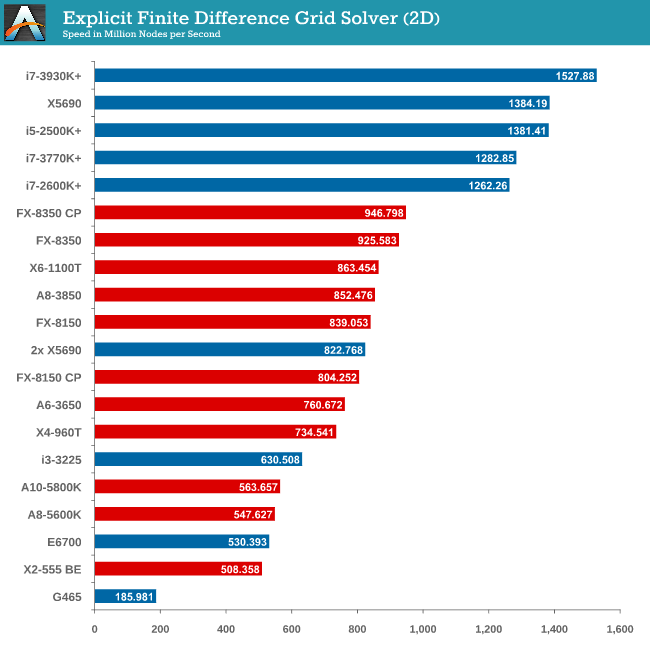
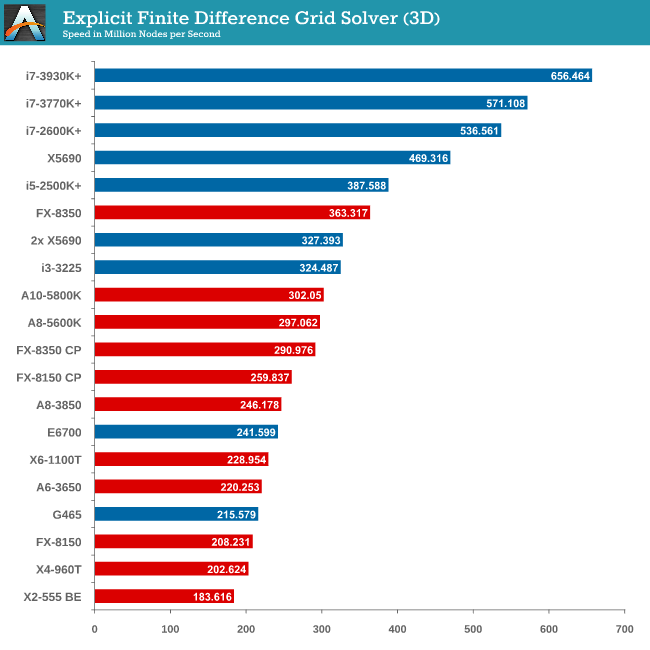
Grid solvers do love a fast processor and plenty of cache in order to store data. When moving up to 3D, it is harder to keep that data within the CPU and spending extra time coding in batches can help throughput. Our simulation takes a very naïve approach in code, using simple operations.
Grid Solvers - Implicit Finite Difference + Alternating Direction Implicit Method
The implicit method takes a different approach to the explicit method – instead of considering one unknown in the new time step to be calculated from known elements in the previous time step, we consider that an old point can influence several new points by way of simultaneous equations. This adds to the complexity of the simulation – the grid of nodes is solved as a series of rows and columns rather than points, reducing the parallel nature of the simulation by a dimension and drastically increasing the memory requirements of each thread. The upside, as noted above, is the less stringent stability rules related to time steps and grid spacing. For this we simulate a 2D grid of 2n nodes in each dimension, using OpenMP in single precision. Again our grid is isotropic with the boundaries acting as sinks. Values are floating point, with memory cache sizes and speeds playing a part in the overall score.
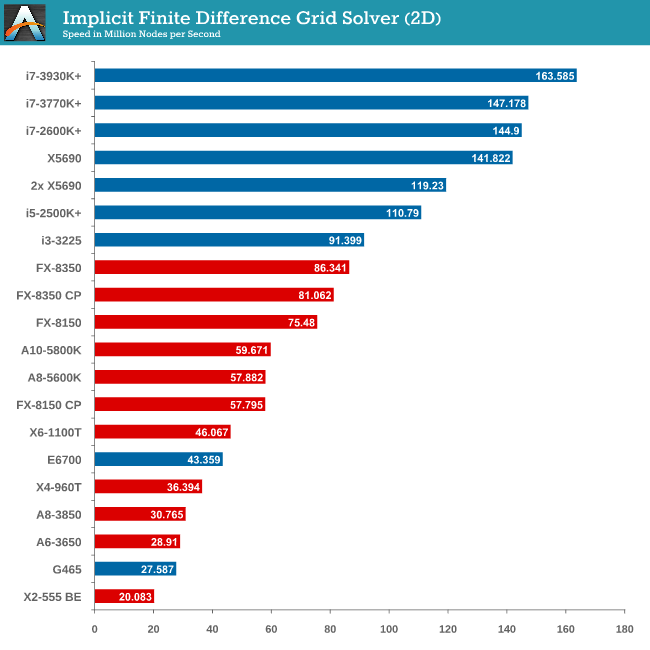
2D Implicit is harsher than an Explicit calculation – each thread needs more a lot memory, which only ever grows as the size of the simulation increases.
Point Calculations - n-Body Simulation
When a series of heavy mass elements are in space, they interact with each other through the force of gravity. Thus when a star cluster forms, the interaction of every large mass with every other large mass defines the speed at which these elements approach each other. When dealing with millions and billions of stars on such a large scale, the movement of each of these stars can be simulated through the physical theorems that describe the interactions. The benchmark detects whether the processor is SSE2 or SSE4 capable, and implements the relative code. We run a simulation of 10240 particles of equal mass - the output for this code is in terms of GFLOPs, and the result recorded was the peak GFLOPs value.
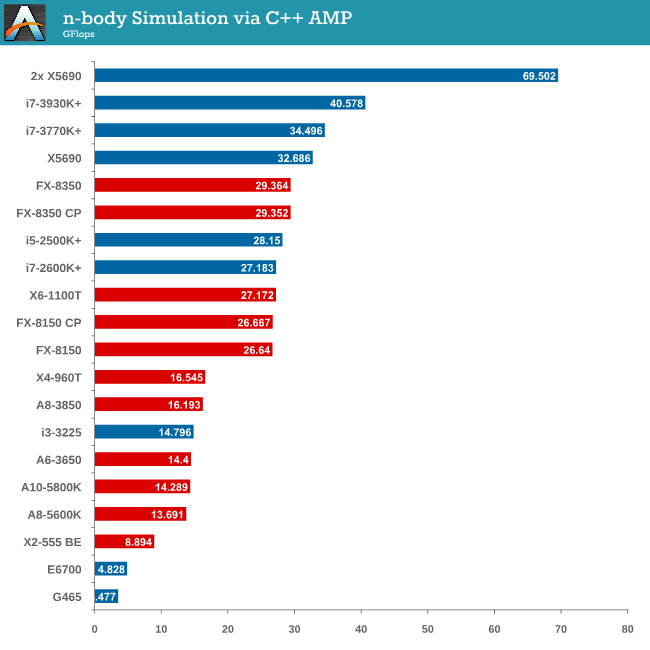
As we only look at base/SSE2/SSE4 depending on the processor (auto-detection), we don’t see full AVX numbers in terms of FLOPs.










242 Comments
View All Comments
TheJian - Wednesday, May 15, 2013 - link
So you're agreeing with a guy that says it's OK to HATE someone but I'm the evil person for pointing out data that is incorrect? HATE? That's not a bit strong? "We might all hate this guy (for good reason)". And people are calling ME offensive? WOW. This reminds me of the gay people who claim to be tolerant, but god forbid any person says something against them (chic-fil-a comes to mind). They want that person tarred and feathered, smear them in the media and never work again, put them out of business, call them names, cheer people who commit violence against them etc...Nice...No double standards there. Another example, Stacy Dash voting for Romney. They called a BLACK woman who spoke her mind a RACIST...ROFL. What? They tore that chick apart merely for having a very well spoken (IMHO) opinion and pretty good reasons for saying them. She didn't sound stupid (despite what anyone thinks about her opinion), but they tarred and feathered her for saying something anti-obama... :( She's a very classy chick if you ask me and they still pick on her (saw some ripping on her on roku last week - msnbc or something).Not sure what his reason is anyway. Did I attack you guys personally? I even let Ian himself off the hook and left the problem at the doorstep of whoever is directing these articles to be written this way. What bothers me most is all the "great article" "nice job" comments to an article that is very wrong and advocates buying a very low end AMD cpu vs. Intel and says it's going to be ok. IT WON'T and in FAR more than just CIV 5 as I showed via other hardware sites.
What part wasn't objective? My data? The other websites giving the opposite of this site? I can't change their data, and there is nothing objective to discuss when the data is just patently wrong as proved.
People can argue I'm not objective on my console beliefs (though backed by sales data, and I freely admit I hate them...LOL but I own an xbox360/2 ps2's - go figure - I don't want another holding my games at 1080p for 8yrs) and the new gen at xmas may sell very well (we'll know in 9-10 months if they scan sell past xmas pop), but the PC comments and data I provided are facts based on data from steampowered's survey, hardocp, toms, and techreport. I could have went with another group also with pcper, guru3d etc...but too many links and this site says your post is spam.
If it was offensive they need thicker skin or stop writing stuff that other sites totally refute. These guys KNOW that when you drop it down to 1080p the cpu is going to SHOW rather than the gpu's shown here (which aren't as taxed at 1080p) showing any cpu can get the job done. Well yeah, any cpu but only when you push gpu's so far they beg for mercy. To me saying that stuff in the article is a LIE when they know what happens turning it down. I wouldn't be so harsh if they were just ignorant of the data, but Anandtech is NOT ignorant. They've been benchmarking the heck out of this crap for ~15 years (I think he started the year I started my 8yr PC business in '97!). I guess you can't call people out for what they're doing today without being called offensive, emotional (LOL) and not objective. I couldn't have written that post if they would have tested where 98% of us play at 1080p right?
What are they doing here at anandtech? Why would they do this? They know what steampowered shows, I basically said the same stuff to Ryan in the 660TI article ages ago but with even MORE proof and using his own articles to prove my points. I used HIS benchmarks.
Ask yourself why we are still waiting for the FCAT articles (now we're up to 2 or more...part 2 of the first, and 7990 data etc)? Ryan said we'd see them in a week. We are into months now.
http://www.anandtech.com/show/6862/fcat-the-evolut...
Where's part2? He still hasn't given us ONE ounce of data using it.
"In part one of our series on FCAT, today we will be taking a high-level overview of FCAT. How it works, why it’s different from FRAPS, and why we are so excited about this tool. Meanwhile next week will see the release of part two of our series, in which we’ll dive into our FCAT results, utilizing FCAT to its full extent to look at where FCAT sees stuttering and under what conditions."
That's from his Part1 linked above. How long do we wait?
Just for kicks:
http://www.anandtech.com/show/6910/origin-genesis-...
"Overall anything short of 5760 with 4x MSAA fails to make a 3rd Titan worthwhile. On the other hand, you do need at least 2 Titans to handle MSAA even at 2560"
Ok, so I need to spend $2000 on two titans to handle some MSAA at 2560 OVERALL in the tested games (heck one hits under 30fps in a game he tested at 1080p in that review). Raise your hand if you think IAN's article is correct...ROFL.
"In three of our games, having a single GPU make almost no difference to what CPU performs the best. "
Yeah in a res that according to Ryan's article taps out two $1000 titans...Then you're right. All cpu's are the same because the Titans are crying for some relief :)
Their recommendation here:
"A CPU for Single GPU Gaming: A8-5600K + Core Parking updates"
"The A8-5600K will also overclock a little, giving a boost, and comes in at a stout $110, meaning that some of those $$$ can go towards a beefier GPU or an SSD."
No way...So you'll buy $110 cpu and according to Ryan's article on the titan box, buy $2000 worth of titans to go with it to run at the resolution Anandtech thinks is important (2560x1440).
How do I respond to that without being offensive? You should hear what I'm saying in my brain right now...ROFL. The sad part is people are reading reviews like this and thinking it's correct. Look at the first comments on this article "nice work" etc...Really? I don't see a bunch of HATERS on my comments anyway. Just a few who at the least 1/2 agree with what I said ;) Yourself included. Your example proves to some degree, I didn't waste my time.
Sorry if you think my "truth" was hidden. I was attempting to make it more "in your face" for simplicity sake. Maybe I failed a bit...LOL. Can't please everyone I guess.
TheJian - Tuesday, May 14, 2013 - link
Nice...What reason? I defamed a hero of yours? Are they doing you any favors by hiding reality? Can you say after reading the links the other sites are wrong? The point of the links showing the exact opposite of this site is so you JUDGE Anandtech yourselves. I really don't want one of my favorite sites to go away. I just want them to start reporting FACTS as they are without the snow.I don't feel I have to be politically correct all day for that. People need to get over that PC garbage and get thicker skins. We are FAR to sensitive today. It's like nobody can take a criticism these days and the person who gives it is evil...LOL.
For the sake of your PC purchase, if you intend on buying on their advice, read the links I gave guys. I'm trying to save people from getting burned! Like me or hate me, the data does NOT lie. You just have to look at it and judge for yourself. When one cpu scores 58 vs. another at 108, there is a SERIOUS reason to pick the proper cpu (just one example from above). If you're seriously broke, I'm all for AMD at that point (great integrated with richland probably making a pretty decent experience), but if not...INTEL. But in either case I wouldn't buy EITHER now. Wait for haswell (broadwell goes in it later...important maybe) or Richland which really makes low end gaming possibly pretty fun I think (at least you can play that is). In laptops maybe Haswell with GT3e makes sense as it should get near AMD or blow by them with 128mb in there. But that's not going to desktops. Integrated on desktops from Intel is still useless IMHO and won't affect Discrete sales one bit from AMD or NV.
tential - Tuesday, May 14, 2013 - link
I don't agree with your analysis on consoles but everything else sure. Gaming for 98% of people is 1080p. That's why I laugh when people quote Titan on ANYTHING (which happens surprisingly a lot here). No one has a Titan so why even talk about such a card saying "AMD has no answer for it". Well no one even has the card anyway except for a couple of people. I agree also with the resolution thing. It makes no sense that so many reviews are catered to high resolution and mutli monitor setups.at?People have been wondering why NV and AMD have increased top of the line GFX cards and it's because quite simply, few people have everything needed to exploit such cards. I'd get a 7970, but I don't have a multimonitor setup or a high resolution monitor so what's the point?
Console wise I think the WiiU was a bad for any comparison. It was an upgrade that really brought nothing extra. People who have a Wii don't care about graphics so most of the upgrades of the WiiU are meaningless to Wii owners. The new Xbox and PS4 will be much better in terms of sales.Those console gamers have been dying for a graphics boost.
In the end though you're response explains to me GPU pricing today and why top of the line GPUs are costing more and more. A smaller percentage of people are buying them, because GPUs that are lower end, or GPUs that are older are perfectly capable of doing the tasks needed by gamers today. Maybe when monitors drop in price and more people game at higher resolutions but for now, most people do 1080p, and that's the sweet spot for most people. I know thats the ONLY resolution I ever look and care about.
TheJian - Wednesday, May 15, 2013 - link
Thanks...Console arguments are like ford vs. chevy right? How many people won that argument back in the day? :)If consoles sales after xmas pop continue for 6 months after (unlike wiiu etc that died as Kotick etc point to, wiiu off 50% says something, Vita, 3DS etc down from last revs too, software off also for all), I'll come back and say YOU sir were right :) You have my word. Of course it goes without saying, I'll be saying the exact opposite if it doesn't happen.
Regarding why we need more power...I can show situations where 1080P brought the top end to unplayable. Hardocp just did this.
http://hardocp.com/article/2013/03/12/crysis_3_vid...
They had to turn some settings down even on 680 and 7970ghz and cards below this really turned stuff off (670 etc). People can say, well this or that doesn't make much difference visually, but the point is you can't have everything on without more power (maxwell/volcano should finally make everything on 1080p playable with ALL details on, no sacrifice at all in anything I'd hope).
"Crysis 3 plays a lot better at 1080p resolution, 1920x1080. At 1080p the GeForce GTX 680 and Radeon HD 7970 GHz Edition are able to push the graphics to very high and play with the best experience possible in the game. Granted, we have to use SMAA Medium in order to achieve this. It will most likely take next generation single-GPU video cards to allow us to play at SMAA High 4X at very high at 1080p."
Tombraider has the same issues only worse I guess. :
http://hardocp.com/article/2013/03/20/tomb_raider_...
"If you are interested in playing Tomb Raider the NVIDIA GeForce GTX 680 provided the fastest performance at 1080p, and was the only single GPU video card capable of playing with 2X SSAA at this resolution. At 2560x1600 the AMD Radeon HD 7970 GHz Edition CrossFire setup will provide more performance. For gaming on a budget, or at resolutions lower than 1080p, the GeForce GTX 660 Ti is an excellent option."
So the 660TI I almost bought is for LOWER than 1080p?...ROFL. OUCH. As they point out two cards for above 1080p and only the 680 survived 1080p itself, and only at 2xSSAA. I can site more examples also, but this makes the point. Even 1080p is tough for top end cards if gaming as the devs intended with all candy on is attempted. We need more power, and 20nm should give this from either company I hope. I hope I'll have enough of a reason to buy 1440p for a few games, then flop it over to my dell 1920x1200 when the new cards can't hack my 27in I plan to buy (if I do, might stick with 27in at 1080p, but I like having 2 resolutions native on the desk to play whichever my card can handle). It's comic ryan was pussing 1440p for the 660TI article, but hardocp says that card is for BELOW 1080p...LOL.
ShieTar - Monday, May 13, 2013 - link
Well, if even older dual core CPUs and the weaker AMD parts don't scale at all with a single GPU, it would seem to me like a 60$ Pentium or even a 40$ Celeron with a bit below 3GHz might make a great companion for the typical a 200$-GPU for a Full-HD Gamer. Would be interesting to add any one of those low-cost Ivy Bridge parts to the comparison to see how they keep up with their core ix counterparts.trajan2448 - Tuesday, May 14, 2013 - link
As soon as I saw Crossfire I stopped reading.TheJian - Wednesday, May 15, 2013 - link
One more comment on FCAT missing - From the 7990 review:" The end result is that we’re not going to have FCAT data for today’s launch, as there simply hasn’t been enough time to put it together. FCAT was specifically designed for multi-GPU testing so this is an ideal use case for it and we’d otherwise like to have it, but without complete results it’s not very useful. Sorry guys.
The good news is that this means we have (and will be compiling) FCAT results for our cards based on the very latest drivers. So we’ll get to the bottom of frame pacing on the 7990, GTX 690, and more with an FCAT article later this week or early next week. So please stay tuned for that."
So we're 3 weeks later and no review for this data STILL. Again, people realize the delay tactics here. In another week it will be a MONTH. This is on top of already waiting for FCAT part2 article I mentioned already.
"Our goal with FCAT was to run an in-depth article about it shortly before the launch of the 7990 as a preparatory article for today’s launch. However like most ambitious goals, that hasn’t panned out."
It's not really ambitious when EVERYBODY else is already presenting data article after article. Just keep making excuses. Take a good look at the credibility of this site here people and judge these guys yourselves. Ryan Shrout seems to be able to pump out article after article on FCAT, including his review for the 7990, Titan etc...Every article discusses it at this point. Is Ryan Shrout at PCper.com so much more effective than this huge website? Ryan's asking for donations to upgrade his camera equipment for recording podcast type stuff etc. How many people do you have working here compared to his little site? Which I love BTW. Great site, and he nearly has doubled the funding the asked for :)
At some point I hope people start asking you guys more questions after looking at my posts pointing out stuff most just seem to miss. People will eventually JUDGE this site accordingly if you keep this stuff up. I sincerely hope this site returns to good neutral data soon. You can start with an FCAT article that makes other sites like PCper seem as small as they are.
Are you still trying to figure out how to use it or something? Call Ryan Shrout :)
bds71 - Wednesday, May 15, 2013 - link
Ian: i noticed you were GPU bound a lot. doesn't this sort of defeat the test? (i think you were GPU bound more than 50% of the time). i'm curious why you didn't use eye-finity or nVidia surround to test the quad graphics setup? with that much power under the hood it's almost a necessity. anyway, i don't mean to critisize the review, i think it still had some very usefull information. i just think that the conclusion wasn't complete if you're GPU bound. note: and decreasing the graphics so that your CPU bound is unrealistic - nobody with quad graphics is going to reduce the graphics capability so their CPU bound.bds71 - Wednesday, May 15, 2013 - link
edit: i just read through (most) of the comments above. and, while 98% (doubtful, but OK) may play on a single 1080p screen, the fact is that high end graphics are a waste of money for a single 1080p monitor. and, while some games (like Skyrim and Civ V) use a lot of processor, that type of scenario is not indicative of most games. note: also, most of those 98% single screen 1080p users also probably DON'T have a top-of-the-line (ie: 980 or 7970, much less titan, 690 or 7990) graphics card. they probably have a 200-$300 graphics card and a 100-$250 CPU (ie: mainstream). nor do any of those less than top-of-the-line *need* anything more than single 1080p monitor and a mid-range CPU (of which the AMD or Intel variety will do just fine for 98% of those 98% with a single monitor) from my point of view this article set out to find out how much the CPU is used in gaming. does it make sense then to put a limit on the graphics capabilities? of course not. so you go with the high end (top-of-the-line) graphics solution. but in the end, the graphics capabilities was still limited by the screen resolution - you couldn't really see what the GPU's were/are capable of because they couldn't really stretch their leggs (and, in turn, the CPUs never stretched to their limits to feed such a request).i participate in F@H. as such i also use my GPU's. i've noticed that (depending on the work unit) the GPU's can take as much as 20% of the CPU to keep them fed. is gaming really that much different? the CPU is needed to feed the GPU, and to do those functions that can not be done on the GPU. for folding, it doesn't matter how fast something gets done - so a faster CPU isn't imperative. but, for gaming, the speed of CPU and its ability to keep relevant data going to the GPU does matter. when the CPU can't keep up with the GPU you get slow minimum frame rates and a general "slow" feeling from the game. so, yes, i agree minimum frame rates are important when determining what CPU to use when feeding a high end graphics solution (more so when using more than a single GPU solution). but you still have to let the GPU's stretch thier legs to see how much of the CPU is being used - and that will determine if a CPU is good or not (min frame rates and CPU usage with high end graphics at appropriate resolutions)
yhselp - Wednesday, May 15, 2013 - link
Wow, the sheer amount of 'content' that Jian guy is producing is amazing. You could probably publish a few books worth of comments by now. Is it really necessary to hit everybody up with a 1000-word reply?What I don't get is why you actually do this. You don't agree with what's been tested and how the data has been interpreted; okay, that is your right. And, yes, some of the conclusions drawn might be controversial; but what's your problem? Why don't you just voice your opinion once and leave it be? What are you doing here - are you some sort of freedom fighter for objective data on the internet?
You complain about how AnandTech are doing it wrong and claim that your own observations are objective and valid. From your point of view they might be, but what you are forgetting is that testing hardware is so vast a field, with so many variables that it's impossible to scientifically claim that ANY conclusion is objective, since the very essence of what you're dealing with precludes that. Everything (in hardware testing) is subjective - live with that truth.
It's not about having "tough skin", but having manners and being civilized. You can't expect people to listen to you and take you seriously if you're being rude even if your arguments are valid. Try a more gentle approach - I guarantee your message, whatever it might be, will travel further.
Remember, this is not an article about choosing a CPU for 1080p gaming, also, it's not complete. The provides information for people to interpret their own way. Yes, it draws conclusions at the end that I too think are best left unsaid; but why can't you just look past them? What is your problem? What are you trying to change here? If you don't like AnandTech so much, why don't you just... leave?